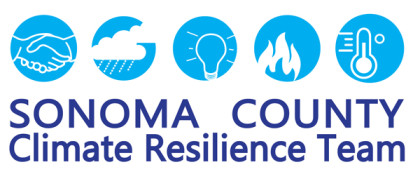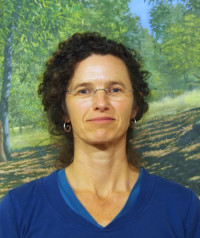Sonoma County experts join White House climate change initiative
 By Anna Pier — When the White House Office of Science and Technology launched its Partnership for Resilience and Preparedness initiative last month, it invited scientists and data experts from around the world to participate in the climate change forum. Among the heavy hitters — U.S. Dept. of the Interior, Google, IBM, Amazon, NASA and 12 other large national and international entities – was one municipality: Sonoma County.
By Anna Pier — When the White House Office of Science and Technology launched its Partnership for Resilience and Preparedness initiative last month, it invited scientists and data experts from around the world to participate in the climate change forum. Among the heavy hitters — U.S. Dept. of the Interior, Google, IBM, Amazon, NASA and 12 other large national and international entities – was one municipality: Sonoma County.
Three Valley residents, Caitlin Cornwall, Research Program Manager at Sonoma Ecology Center; Lisa Micheli, CEO of Pepperwood Preserve; and Jay Jasperse, Director of Groundwater Management at Sonoma County Water Agency; were among the 14 from Sonoma County invited to the Ford Foundation headquarters in New York City.
 Cornwall, a biologist (pictured); Micheli, a hydrologist; and Jasperse, an engineer, are part of the Sonoma County Climate Resilience Team (SCCRT).
Cornwall, a biologist (pictured); Micheli, a hydrologist; and Jasperse, an engineer, are part of the Sonoma County Climate Resilience Team (SCCRT).
The PREP launch was part of the 8th annual Climate Week NYC that, according to sponsoring Climate Group, brings together “influential global figures from business, government and society who are leading the low-carbon transition.” (Ironically, New York City was gridlocked with people coming from around the world to address climate change.)
“It was gratifying to be on the same team as high-level, smart people from all over the world,” said Cornwall, who experienced “euphoria about putting shoulder to the wheel with so many skilled and capable colleagues. It felt like participating in one of the big challenges of human history.”
How was Sonoma County chosen by the White House? Both Cornwall and Micheli credit the unusual and successful partnerships forged to tackle the County’s climate vulnerability. These collaborations are a credit both to broad-minded local government, agencies and elected officials, and to broadminded local non-profits, who see the benefit of working together and partnering with leading scientists.
Cornwall points out that the level of buy-in reflects awareness that Sonoma County’s economy, based on symbiotically-related agriculture, natural beauty and tourism, is highly vulnerable to the risks and hazards of climate change.
Jasperse is no stranger to large international convocations. He served on a 12-person NATO delegation that met in Egypt with representatives of developing countries to discuss reliability of water supply and water quality. He also traveled to South Korea as part of an 11-person National Science Foundation delegation. As to the White House PREP launching, Jasperse said he “felt really honored to be there.” He added that it struck him that “the collaborative way we work together in Sonoma County is a good template for other areas” across the country and around the world.
In 2007, when Dr. Micheli was working on restoration projects for the Sonoma Ecology Center and in Napa, she co-founded the North Bay Climate Adaptation Initiative (NBCAI). She points out that was the year “An Inconvenient Truth” came out. She did a philosophical turnaround, realizing the necessity of incorporating climate change into all projects and planning. The work of NBCAI is foundational for the team that went to the White House-sponsored gathering.
Micheli, acknowledging the daunting proliferation of long agency names, acronyms and terminology, explained that “adaptation” refers to long-term planning for climate change, while “resilience” addresses, for instance, how to deal with this year’s drought. Cornwall elaborated, saying “resilience is not necessarily short-term. It means the ability to recover from a disturbance. Ideally our communities, natural resources, and economy adapt to the reality of climate change by becoming resilient to its impacts.”
Jasperse said he relies on the National Academies of Science definition of resilience: “The ability to prepare and plan for, absorb, recover from, and more successfully adapt to adverse events”.
Speaking of the local team’s role at the launching event, Cornwall said that other participants came to New York with “their pieces of the elephant,” but the Sonoma County team has actually assembled “most of an elephant.” Cornwall says that North Bay Climate Adaptation Initiative’s work provides the missing piece of the puzzle, reaching to the broadest possible audience with the local climate adaptation message, Most recently NBCAI published, with Cornwall as lead author, “A Roadmap for Climate Resilience in Sonoma County,” which readers can find at Northbayclimate.org.
What the new PREP partnership offers those involved with climate resilience in the county are the tools to do “what we already knew we wanted to do, which is to make data, including projected future climate conditions, accessible, so it can inform the decision-making of government agencies and individuals everywhere.” These tools include data storage and dissemination. Micheli explained that they collaborated with the White House to create the Sonoma County Climate Resilience Dashboard. Jasperse said one of the challenges was to downscale the model to “watershed scale.” Visit the interactive beta site at: http://www.prepdata.org/dashboard/understanding-sonoma-countys-climate-adaptation-plan/data
Jasperse explained that the Dashboard is a “beta” version because it is “demonstration scale.” He elaborated that at its launching the Dashboard covers three areas with regard to climate change that are agreed upon by “those of us working in the weeds.” 1) It will be hotter; 2) precipitation will be more variable – the wets will be wetter, the dries will be drier; and 3) sea level will continue to rise.
He said the Water Agency had been working with EarthKnowledge, an international environmental information technology consulting firm, on an earth science data model simulation. “We have so much data and analysis, but it is too much for the general public or policymakers.” So the new Dashboard is “a way to leverage all of the local work.”
He sees the next step for the Dashboard is to expand the modules. For instance, create a health services module that would help those planning for seniors, the homeless, and other populations most vulnerable to climate change.
Micheli said, “We are really leaders in this.” She attributes their collaborative success to the classic kindergarten skill of learning “how to share.” Perhaps the last factor in the selection of our county is highlighted in the White House’s joint declaration about the PREP event: “Open, accessible, and timely data are vital to development and humanitarian efforts across the globe.” And Sonoma County has an international partner in the form of a sister watershed in Corpocaldas, Colombia, also present at the PREP launch.
The other members of the SC Climate Resilience Team who attended the event are Supervisors Efren Carrillo and James Gore, both directors of the Water Agency; from Sonoma County Water Agency Grant Davis, Ann Dubay and Brad Sherwood; their consultant Lisa Renton; Lauren Casey of Sonoma County Regional Climate Protection Authority, and Allan and Lorrie Flint from USGS. Dubay made the presentation to the whole assembly on behalf of the Sonoma County group.
One thought on “Sonoma County experts join White House climate change initiative”
Comments are closed.




I would be nice to see Sonoma County set an example for other jurisdictions.